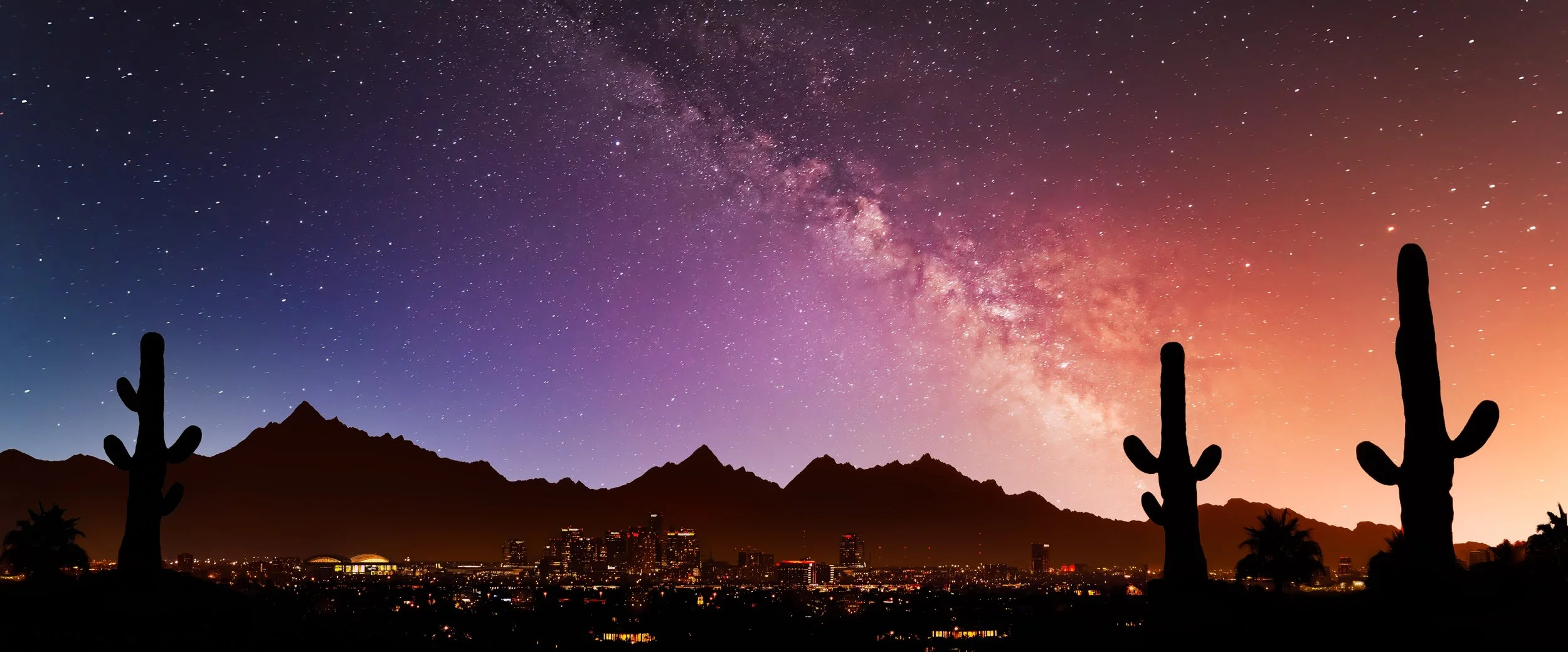Night Sky Viewing in Tucson
Did you know that Tucson is one of the best cities in the world for night sky viewing? That’s right, the Sonoran desert home isn't just great for sunsets, hiking, or amazing food. Aside from having a high altitude, low humidity, and clear skies, Tucson is a designated dark-sky city which makes it a perfect location for stargazing. Additionally, Tucson is home to several observatories and parks that offer some of the best views of the night sky.
What does it mean that Tucson is a dark-sky community? There are ordinances in place to reduce light pollution so that the sky at night is as dark as possible. This means no unshrouded streetlights and very little light from businesses after dark. Tucson is the darkest city of its size in the nation. And with over 350 sunny days, the likelihood of a cloudy sky is pretty slim! Furthermore, the low humidity in Tucson means less atmospheric distortion, so the skies are clearer to the naked eye. The result is some of the best stargazing in the country.
Where should I go to see the stars?
There are several parks and areas around Tucson that offer excellent night sky viewing opportunities. One of the most popular locations is the Kitt Peak National Observatory, which is located about an hour outside of Tucson. While temporarily closed due to a fire, once it re-opens, it’s worth booking tickets and making the trek. The observatory offers nighttime tours and stargazing programs, giving visitors the chance to observe the night sky through powerful telescopes. Pro tip: It’s much colder and windier on the mountain so pack a warm layer!
If you’re up for an adventure, another great location for stargazing is Mt. Lemmon SkyCenter, which is located on top of Mt. Lemmon, the highest peak in the Santa Catalina Mountains. The SkyCenter offers nighttime stargazing tours as well as daytime solar viewing tours, providing visitors with the opportunity to view the sun through special telescopes.
Explore indoors at the Flandrau Science Center & Planetarium at University of Arizona. Fun for kids and adults alike, the planetarium offers a variety of shows including several about the night sky.
In addition to these locations, there are several parks in Tucson that offer great views of the night sky. Saguaro National Park, Tucson Mountain Park, and Catalina State Park all offer nighttime programs and guided stargazing tours.
Want a more casual evening? Grab a serape blanket, snack, drinks, and go lay down in the yard on the turf! If you’re staying at one of our vacation rentals, they’re located outside of city center in the Northwest part of Tucson, offering a clear and comfortable view of the skies.
What seasons are best?
The best time to view the night sky in Tucson is during the winter months, from December to February. During this time, the skies are typically the clearest, with less humidity and fewer clouds. However, stargazing is possible year-round in Tucson. You might want to skip the late summer months, however, if you’re traveling to Tucson just for the stars. July, August, and often early September are monsoon season, where Tucson gets almost nightly thunderstorms.
What constellations and planets can I see in each season?
In the winter months, you’re likely to catch constellations such as Orion, Taurus, and Canis Major, as well as planets such as Jupiter and Saturn. In the spring, constellations such as Leo and Virgo are visible, as well as the planets Mars and Venus. In the summer, the Milky Way is visible, as well as constellations such as Sagittarius and Scorpio. In the fall, visitors can see constellations such as Pegasus and Andromeda, as well as planets such as Uranus and Neptune. So, whatever season you decide to visit, you’ll likely be in for some stunning views.
Curious what’s inside the telescope?
University of Arizona is home to the Richard F. Caris Mirror Lab that most notably crafted the mirrors on the Hubble Space Telescope and in the Giant Magellan Telescope. Nestled on the school campus, this incredible operation of engineers, scientists, and technicians construct large lightweight mirrors with unprecedented surface accuracy.
What else should an out-of-state traveler know about night sky viewing in Tucson?
When planning a trip to Tucson for night sky viewing, it is important to dress warmly, as temperatures can drop significantly once the sun goes down, especially October through April. If you’re planning on heading up the mountain, you should also be prepared for high elevation (colder temps) and bring plenty of water to stay hydrated. We also recommend visiting one of the many observatories or parks that offer guided tours, as the experts can provide helpful insights into the night sky and point out features that may be difficult to spot on one's own.
If this sounds like a vacay that’s right up your alley, we happen to have some ideas for where you could stay while you’re in town! Click here to view our luxury vacation rentals and start planning your Tucson getaway today!

